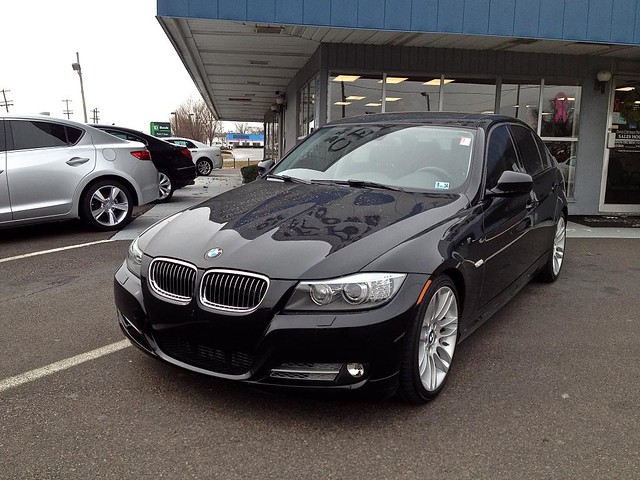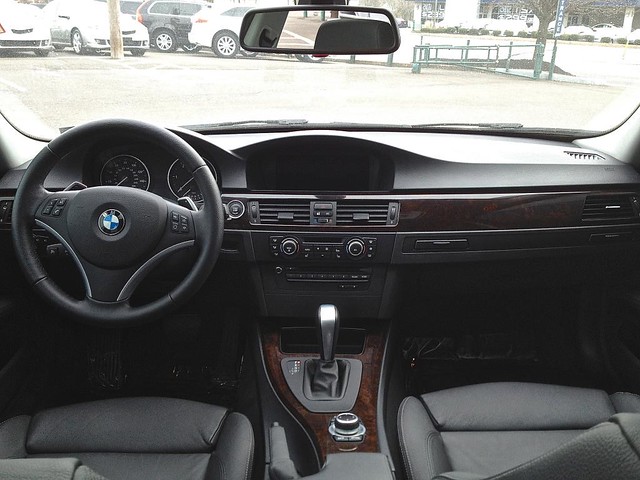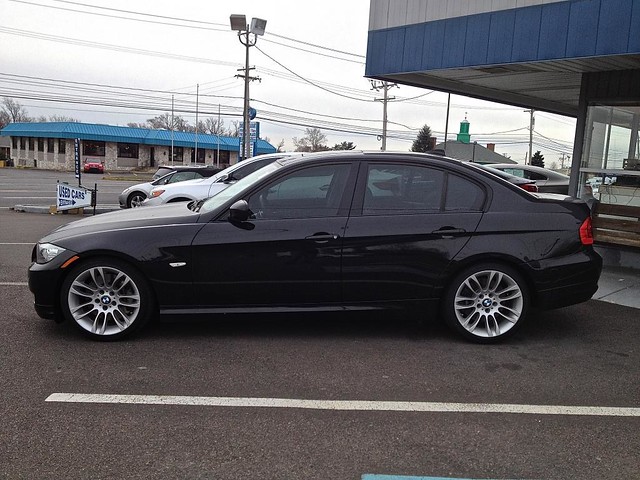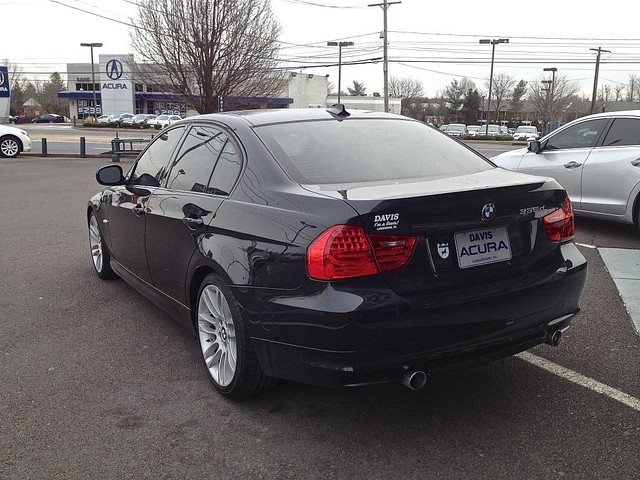
The 335d was a bit of an oddball on the American market. It was the highest performing diesel version of the E90 3 Series, and BMW sought to see how Americans would receive a top range diesel car. Diesels are huge in Europe, but have a much smaller market share here in the States. Considering that, along with the fact that the 335d was a higher-end model 3 Series, it comes as no surprise that they were not BMW’s biggest seller. That means that today, here in 2013, 335ds are rather uncommon on the used market. It also means that we have to change the way we look at the car now that it is only available pre owned.
Those people who did buy 335ds will absolutely swear by them. To most uneducated Americans the notion of diesel power evokes thoughts of black smoke and the loud rattle of a dump truck. Anyone with actual experience in a modern diesel car will tell an entirely different story. They will tell you about the solid performance, and incredible fuel economy, about a car that both runs clean, and is great fun to drive. Diesels like the 335d are sort of a insider secret in America, those who know, know, and those who don’t know waste their money on (mostly) gutless hybrid cars.
I had driven a 335d once before, but only very briefly. I decided to go out and try another one for two reasons: First, to see how it fairs in the context of the used market. Second, to compare it to the new F30 3 Series that I reviewed recently. Lets face it, BMWs are very overpriced brand new, with all kinds of options that nickel-and-dime you to death. A smart car buyer knows that BMWs should be purchased secondhand, with low mileage and some remainder on the factory warranty. By doing this, you save yourself the vast depreciation that comes from spending so much on all of those fancy options, as well as the BMW brand mark up. I will go into the specifics of this for the 335d later on All you need to know for now is that 335ds are currently right in the sweet spot of the secondhand BMW market.
Appearance
One concern for many used car buyers is having a car that looks noticeably dated, and out of style. That shouldn’t be an issue here because the E90 3 Series and the current F30 3 series have a similar, sort of sculpted look to them. The 3 series variants before the E90 were all handsome, but a bit plain looking. That changed with the E90, which had a noticeably more sophisticated design. The new F30 actually has many of the same lines present in its design. I happen to like the E90’s design a little better than that of the F30 because the F30 has some awkward elements in its headlights and front facia. The E90 by comparison just looks entirely handsome, and well proportioned.
It is this “handsome” element that I think defines the BMW look. It is not an elegant, and classically beautiful sort of essence, like that of a Lexus. No, a BMW is supposed to be more of of a suit with and open collar sort of car. Posh for sure, but not overly fancy. I think this 335d exudes that image, especially in this very Transporter-esque black on black. I also really loved the spilt-spoke premium wheels, and how the car sat a little more poised on its sport suspension. Looks-wise, this 335d pretty near ideal for what I’d want in a Bimmer.

Inside
It turned out that this specific car was dressed to the nines, having every option available. Being a 2011, it still has almost everything available on a brand new F30, including BMW apps… which I happen to hate because nobody should be updating Twitter while driving. It also had Navigation, parking assist, phone connection, and all the other stuff people want these days. Despite being a late model car at this point, it is still pretty up to date because 2011 just wasn’t that long ago.
When in the car, the seats are quite comfortable. You sink in a good amount, but once you’re settled it is actually very supportive as well. BMW’s have always been made with spirited driving in mind, so they make sure the car will hold you in your seat nice and snug. As to be expected, the driving position is excellent, and the wheel is adjustable in all directions. There is fine leather all over the interior, and the car I drove even had some really nice wood on the dash and center console. Like I said before, this thing was loaded up with options, and it really felt like it.
Practicality-wise, this E90 is a little smaller than the new F30. That is because the F30 3 Series is now the same size as the E39 5 Series, and cars in general just seem to keep getting bigger, and bigger these days. Back when people had more sense (before the marketing divisions were taken over by half-wits), if you wanted a bigger car than a 3 Series, you bought a 5 Series. Now the 3 Series is as big as the old 5 Series, the current 5 Series is as big as the old 7 Series, and the 7 Series is now the size of an aircraft carrier….. when does it end?! The point in me saying all of this is so you can realize how foolish their approach is. The E90 3 Series worked just fine for people in 2011, and nothing has magically happened that makes it any less useable for people in 2013. This 335d will still seat 5 people, and it still has plenty of room in its trunk. Maybe if people start realizing this, BMW might stop making their cars more obese with every new generation.

On the Road
The first thing that hit me about the car when we set off was the steering, I had forgotten how great it felt. The E90 has BMW’s old hydraulic power steering, and the F30 has their new electric power steering. The difference is huge, if I’m honest. The E90’s steering has a solid weight to it, and feels connected to what the car is doing in a raw, mechanical sort of way. It is also hyper responsive, and sharp feeling. Every little adjustment you make with your hands brings and instant response from the car. This is what people mean when they talk about a car feeling “connected” to the driver. By comparison, the steering of the F30 feels like more of an appendage than an integral part of the car. It responds well, but there is no tactile solidarity, and the car is much worse off for it. So in the steering department, this E90 335d is in an entirely different league than its successor.
The 335d only came with a six speed automatic transmission, but the car I drove was fitted with the optional paddle shifters. I am a big fan of paddle shifter on both automatic and dual clutch equipped vehicles because it gives you a little bit of fun to make up for the lack of a clutch pedal. Shifts in this 335d were quick enough, but there was still a slight delay. It is clearly not as modern as BMW’s current eight-speed automatic, but I would say it is among the best “tiptronic” transmissions of the previous generation. In a nutshell, yes its automatic, yes I’d prefer a manual, but no, it doesn’t get too much in the way of the experience as a whole.
When tossing the car through corners, more advantages over its successor appear. The 335d was a lot more composed in its handling than the F30. This car had the optional sport suspension, and it felt progressively more confident that harder I pushed it through a corner. The F30, on the other hand, had a point around 8/10ths where it kind of fell flat, and just didn’t want to be pushed any harder through a turn. The 335d still handles like a proper 3 Series, with loads of performance available to be exploited by a capable driver. The brakes are solid too, with a nice progressive feel from the pedal. As far as cornering performance goes, this E90 335d is actually a few steps up from the current F30 3 Series. Road and Track’s performance tests back me up with hard numbers They saw the 335d go through the slalom at 70.5mph, and stop from 60mph in 116ft, 1.5mph faster and 8ft shorter than the F30 328i managed. The 335d has truly solid performance available on winding, technical roads.
Diesel Power
So far I have found that the 335d drives and handles like a proper 3 Series, but the truth is those are both secondary aspects to what makes this car so unique. The diesel power under the hood is really what sets this car apart from the crowd.
I’m going to start by saying that this car probably has the most accessible powerband I have ever experienced. You plant the gas in any gear, in any situation, and the thing just takes off. Under the hood there is a 3.0L twin turbo diesel engine. One turbo is small for quick response, and the other is big for power up high. The result is mind boggling performance on the street. Passing, merging, and just raw acceleration is entirely effortless, and feels quite brutal.
BMW claims 265bhp and 425ft/lbs of torque, but real world dyno results show the 335d is actually more in the range of 300bhp and 500ft/lbs of torque….. a truly massive amount of grunt in a car this size. Keep in mind, that while the M3 has 414bhp, it also only has 295ft/lbs of torque, so it doesn’t seem to pull as hard as this diesel does. A few years ago I drove a 335d back to back with a 335i, and while the gas powered 335i was maybe just a hair faster top-end, the diesel’s performance was just so much easier to use in traffic. So if it is 335d vs 335i, I’m picking this diesel every time….. based on performance alone, not even considering mileage.
When you also consider fuel milage, things just become unfair. The EPA’s numbers for the 335d are 23city/36hwy mpg, but a real world test by MPG-O-Matic yielded 43.9mpg on the highway and an observed average of 35.1mpg…. all with rather saintly driving I suspect. A search around the web for results from real owners showed that people were regularly seeing upper 30s on the highway, under the 80mph driving circumstances found in reality. They also seemed to be averaging around 30mpg total with very mixed driving. Overall, I think it should be possible to get close to 600 miles per tank on a reasonable highway trip. So you could say the fuel economy is truly phenomenal, given the type of car this is.
Now, with the fuel economy in mind, consider that this car also offers an astounding level of performance. The 335d feels incredibly fast in the real world, and it backs it up with performance tested at the track. Road and Track recorded 0-60 in 5.3sec, 0-100 in 13.4sec, the 1/4 mile in 13.8sec @ 101.4mph, and top speed limited to 155mph. All of this in a luxury sport sedan that also handles great, and can see 40mpg. If you didn’t know modern diesel before, I hope you are starting to learn now that fuel economy and high performance can indeed be good friends.
In the market
Let’s talk about value for money. This 335d is only two years old, with 24,700 miles on it. This is a German car, so it’s really just getting broken in at this point, and it still has 25k left on its factory warranty. Brand new this car easily would have cost close to $60 grand, but now it can be had for just $36,000.
This means that the previous owner spent nearly $60k, kept the car for two years of decent driving, and sold it for probably around $30k to the dealer. That is a $30,000 loss they took in depreciation, or around $15,000 per year!!! Where as, now, if you buy this car for $36k, you won’t be paying the absurd markup, or the insane prices for all of those options. You just pay the market value for the car, and that’s it. In all honesty you could probably buy this car now, drive it for two more years, and still sell it to someone for over $30k. This is why you buy premium European cars secondhand, and also why the 335d has gone from being overpriced as a new car, to an incredible value as a used car.
$36k is around what you would pay for a new F30 328i with a few cheap options on it. Or you could be intelligent, and buy a 335d like this one. You will wind up with a car that is better looking, nicer, better equipped, faster, better handling, and way better on gas. It seems like an absolute no-brainer to me.
Also, nobody should complain that “diesel is too expensive”. All of these European luxury cars require premium gasoline anyway, which is about the same price as diesel overall. (Diesel is usually cheaper in the summer and more expensive in the winter, compared to premium gasoline)
Sum up
The 335d is an incredible car for the people who know about it, and now it can actually be had at a decent price. The car I drove was listed at $36k, but prices can get into the mid $20k range for cars with more miles on them. They are pretty uncommon to find, but you can find them if you look, and are willing to travel to get one. The reward for doing so is an unparalleled mix of luxury, high performance, and great fuel economy. The 335d is worth seeking out in my mind, and I may decide to do just that when it comes time to buy my next car. Running costs are a concern with any BMW, but if you’re talking under 50k miles, then you probably have a while before you’ll need to worry.
This is a very solid car, and it is a much stronger 3 Series than the one that replaced it. The E90 still has the poshness that modern BMW clientele love, but underneath it is still a great driver’s car at heart. The new 3 Series falls short, so I guess my advice here is to get the 335d while it is still fresh. It will always be a solid buy because of the well rounded package it offers, but maintenance costs could become a concern as mileage increases. We are at a point now where many 335ds will be coming off lease, and will be available in clean form on the used car market.
The 335d gives you everything you expect from a BMW 3 Series, but with the added benefits of diesel power on performance and mileage. Because of that, it is one of the most well rounded cars out there right now. As an overall package, it has always been very hard to beat, but now it can be had at a decent price, which makes it that much more attractive.
WoM Score: BMW 335d (used)
Primary Function: Luxury: 2
Secondary Functions: Performance(2), Practicality(2), MPG(2): 2
Visual Appeal: 2
Build Quality: 2
Value for Money: 2
Final Score: 10/10
-Nick Walker



Reblogged this on Novie Illya Sasanti.
LikeLike
It surprises me that the US market hasn’t discovered power diesel engines before. I guess it’s a combination of:
– abundance of cheap, big gas engines (V6, V8)
– a (relative) availability of cheap gas, and
– no favorable diesel cost (other than the gain through efficiency)
– The lower quality of US diesel (e.g. higher sulphur) or less availability of high quality diesel
All these factors must have limited the spread of sophisticated (thus expensive) diesel engines, despite their efficiency benefit.
Car diesel engine performance has only been high enough in the last 5 years or so, compared to the existing, simple and robust V8’s and V6’s.
And it’s further helped by an engine downsizing trend that seems to (finally) take place in the US as well.
It’s understandable why things are different in Europe.
Road fuels are heavily taxed in Europe. Gas cost at the fuel station is approximately at 7.5-8$/gallon right now. Diesel is slightly cheaper at about 6.5-7$/gallon.
It’s easy to see why European car builders have so heavily invested in developing diesel technology.
If you add a 30% efficiency gain of diesel over gas (at comparable power) to the cheaper diesel price, the advantage to the car owner is huge.
Consider a (EU) gas-powered car at 30MPG and a diesel powered car at 42MPG; the cost of gas-runner is about 15$/60miles, the cost of the disel-runner is 9-9.5$/60miles
But there’s more besides huge fuel economy.
The relative running silence thanks to lower revs, very high mid-range torque thanks to the turbocharging (where you need it in real life, e.g. for overtaking, towing…), no noticeable smoke (micro particulate filters), less frequent re-fueling, less CO2 emissions, good reliability… Actually all the historical drawbacks of diesel have been solved in the past 10 years and the advantages have been refined further.
Consequence: right now, 70% of all cars in Belgium and nearly half the cars in Germany run on diesel. And I think it might happen in the states as well.
I run a 318d in Belgium (Europe) with 136HP.
I’d love to drive a 335d but for the above scary fuel prices and also because “big” engines (anything bigger than 2 litres displacement) are heavily taxed, most people buy the 2L 4-cylinder here in Europe.
But mind you, this is nowhere near a slow car. It does 9seconds 0-60, and top speed is 130 mph. And I personally average 42 MPG (mixed, city + hwy + freeway). I don’t stop at 80Mph on the highway… cruising at 90MPH is standard, with regular stretches at 120 when driving in Germany. I have 20.000 mile intervals for maintenance and that’s it! Push the start button and go!
My brother’s 320d has 177 HP, does 0-60 in just above 7 seconds and tops at 140MPH. I don’t think this is lousy performance.
There is even a 2litre twin-turbo 123d available in Europe, with 204HP and big torque for the car.
0-60 in about 6 seconds..
By the way, BMW launched a 3 liter triple-turbocharged M550d with 380hp and astronomical performance, the first diesel-powered M-car ever. It’s doing 0-100kph in 4.7 seconds (0-60 in 4.3-4.5 sec?)…. what’s next??
I guess the future of diesel could be bright in the USA…
LikeLike
Maybe the best comment we’ve ever had lol. You made some very great points. Chevy has just shown a Cruze diesel, so hopefully it will sell and America will start making more diesels.
LikeLike
I own a 2011 335D in Black also it is the most amazing fuel efficient smooth riding, wonderfully fast and Awesome car Ever! Warranty just went out I have 40,070 miles on it now and has been perfectly trouble free. 500 mile one way trips to kentucky only require stops for my bladder or to eat 40 mpg on those trips at 80 to 100 mph average speed. Averige 33.6 mpg on daily commute from Annapolis to DC. Fun to Drive and did I say I got it for $31,000 with 15,600 miles on it! What a car, what a buy!
LikeLike
Well done, well done!
LikeLike
I can’t really subscribe to your assessment of the E90 vs. the F30. From my own experience, I found that concerning steering, handling and transmission the F30 is an even bigger step from the E90 than the E90 was from the E36.
LikeLike
Then you must be stepping in the wrong direction my friend, because the E36 puts them both to shame in terms of driving dynamics and handling balance.
LikeLike
Truth.
I *almost* love my 2011 e90 bmw 335d, with its responsive throttle, its heavy steering wheel, and its tons and tons of bells and whistles … Why the “almost” factor? Because I just adore the driving feel of my old, battered, torn-up ’95 e36 bmw 328i, with its even heavier steering, even punchier throttle, and the sickening g-forces from throwing around its far more compact, sleek short and narrow body thru tight turns and 6500rpm redlines… far more balls to the walls feel there.
E36/E46 driver: treat the E90 as a 5series. It’s a pretty sweet luxury highway cruiser / passenger hauler, though it does feel like a cross between a sport sedan and a cadillac…but PURIST BEWARE – it DOES have a non-nominal back seat, a sizeable trunk, and actual -blind spots- with a panoramic mirror.
And compact it ain’t.
LikeLike
Excellent article. I bought this car used in may 2013 fully loaded for 36k with 9500 miles. New was 56,600. They also cpo warrantied it for me. Hope to get many miles out this awesome car!!
LikeLike
Good Blog – diesel for me is by far the best option with soaring fuel prices as long as you get the performance too and in this case you certainly do – nice one visit us too 😉
LikeLike
We bought our 2011 335d with just over 5k miles on the odometer. Since then the overall average is 36.5 mpg. Note that most of the driving is long triips. I just finished a 4k mile tour and averaged 38.5 mpg, and 56 mph. The mpg and mph figures are both corrected downward by carefully using a gps over extended distances. Once in awhile I push down the throttle to enjoy the thrust. Amazing car.
My first car was a Jaguar E-type which i bought new and still have. Google “1R9250” for more.
LikeLike
I tuned mine to 333 bhp and 666Nm
It is a true rocket !
Also took off the top speed limit and now its capable of over 300km/h
Profituning did the job
LikeLike
That’s epic! I bet she’s a blast.
LikeLike
I found one that has 101k miles. I’m not sure if I should buy it.
LikeLike
If you have some extra cash laying around for maintenance it should be solid. Lots of little electrical crap will go wrong, maybe the PS pump too, and other miscellaneous things. If its well within your budget it’s a good buy, but not if you’re even close to stretching.
LikeLike
What do you mean not close to stretching
LikeLike
Your budget.
LikeLike
Great read. I am looking for a 2011 335d.
LikeLike